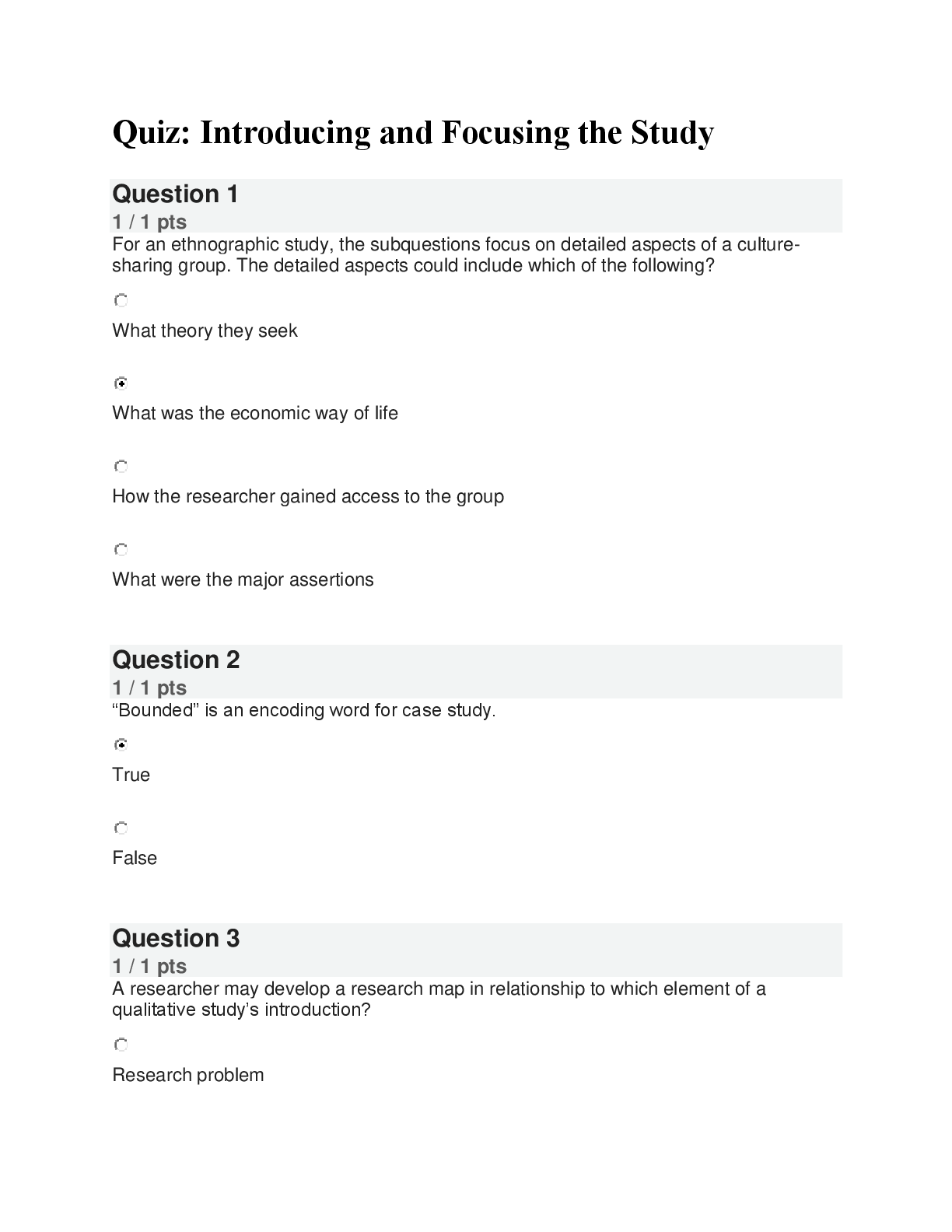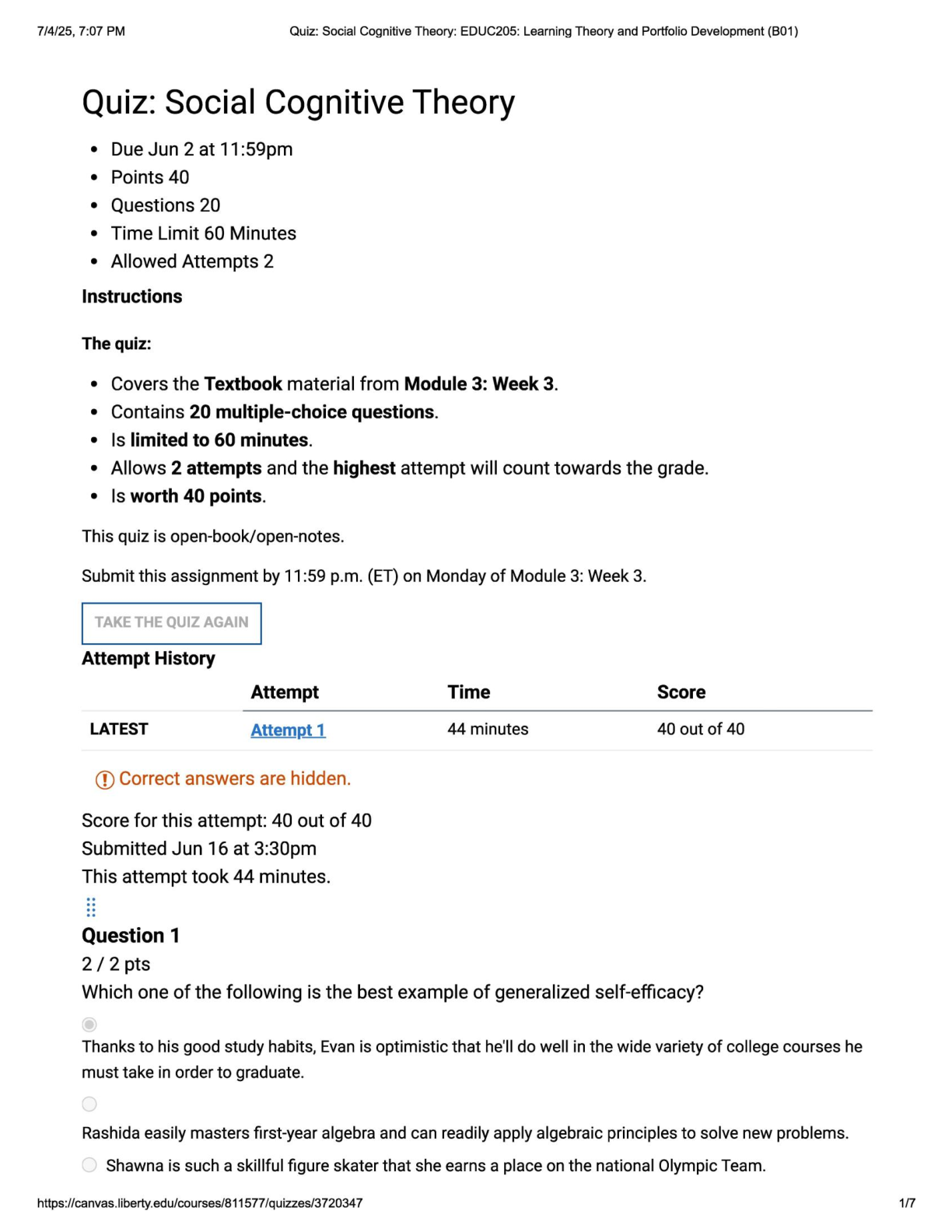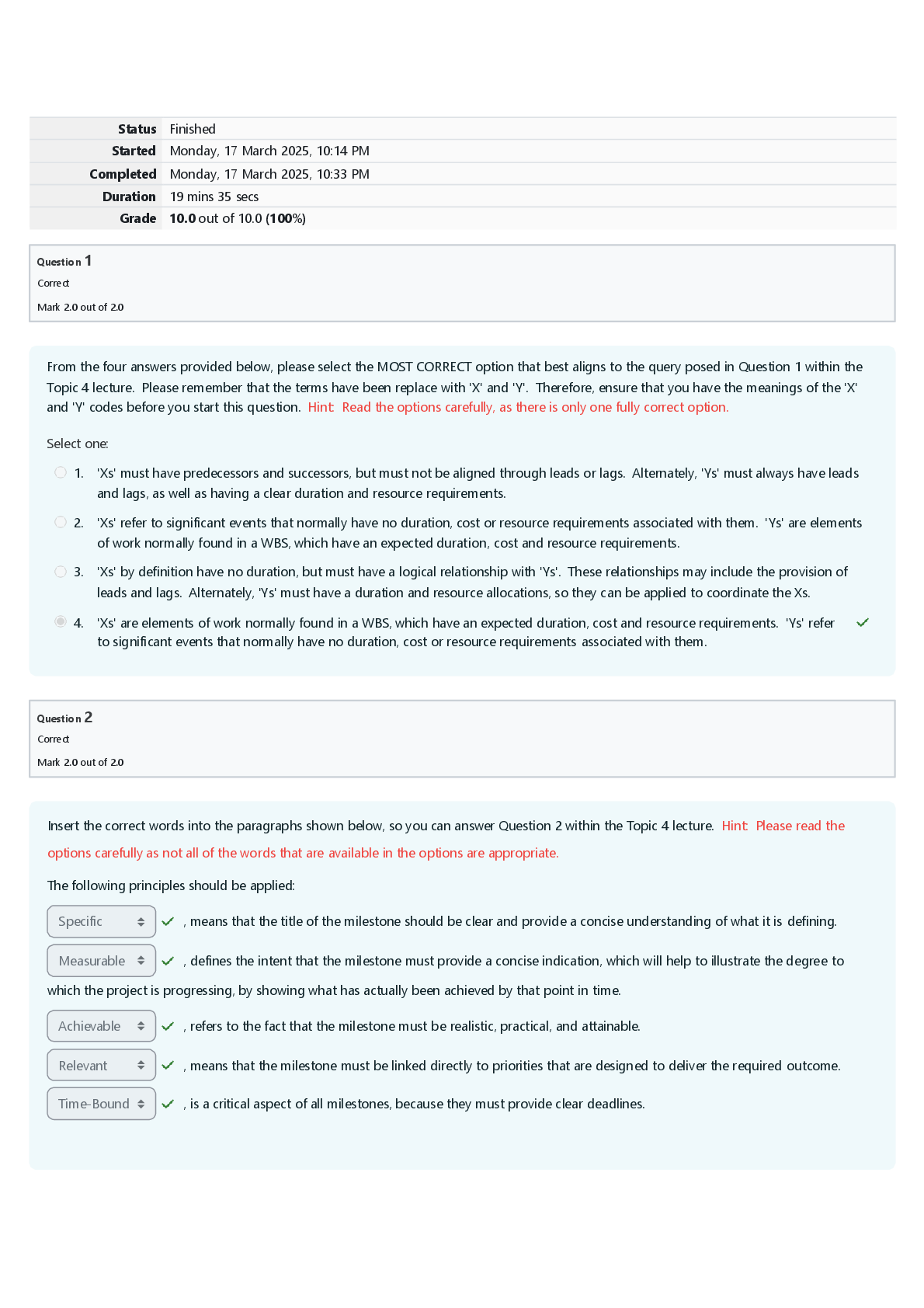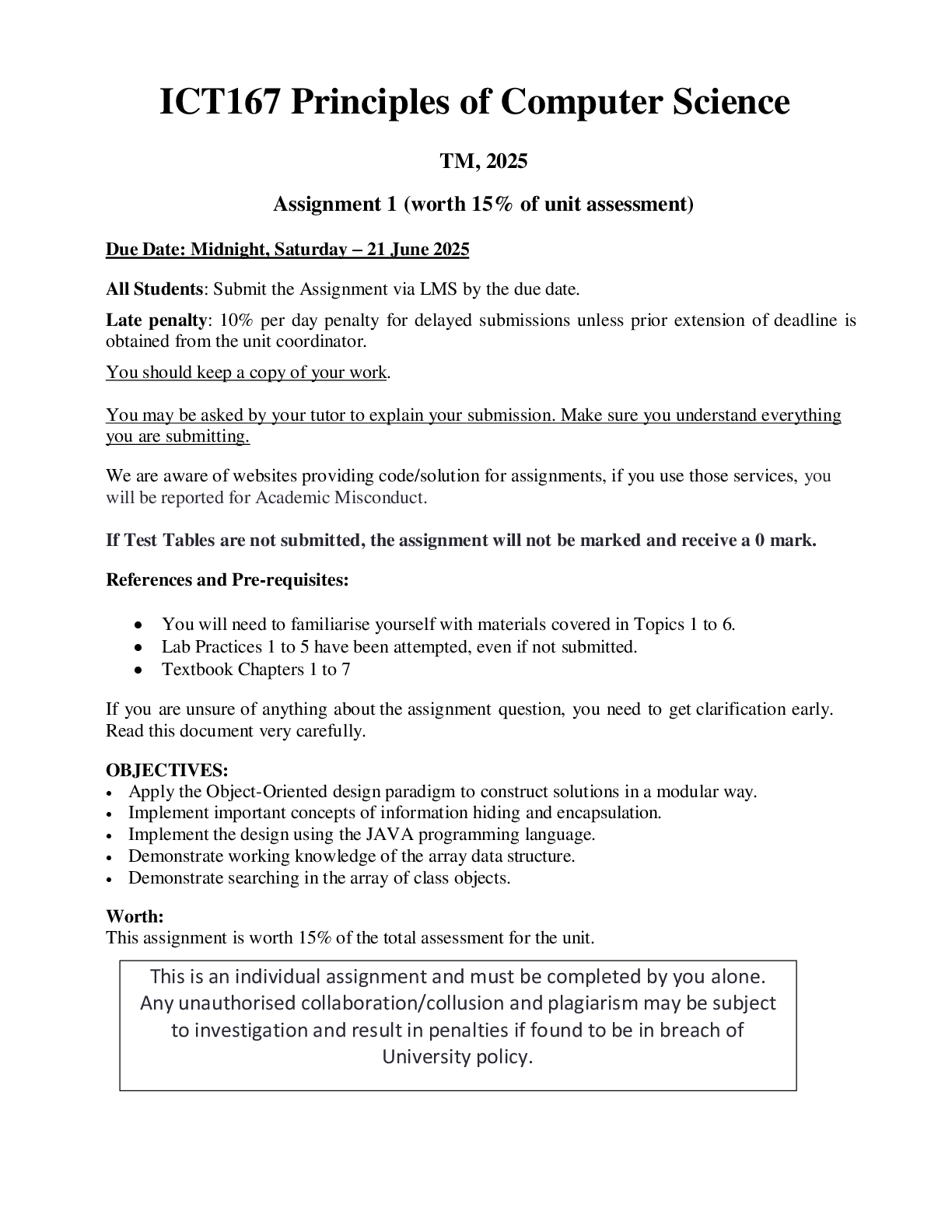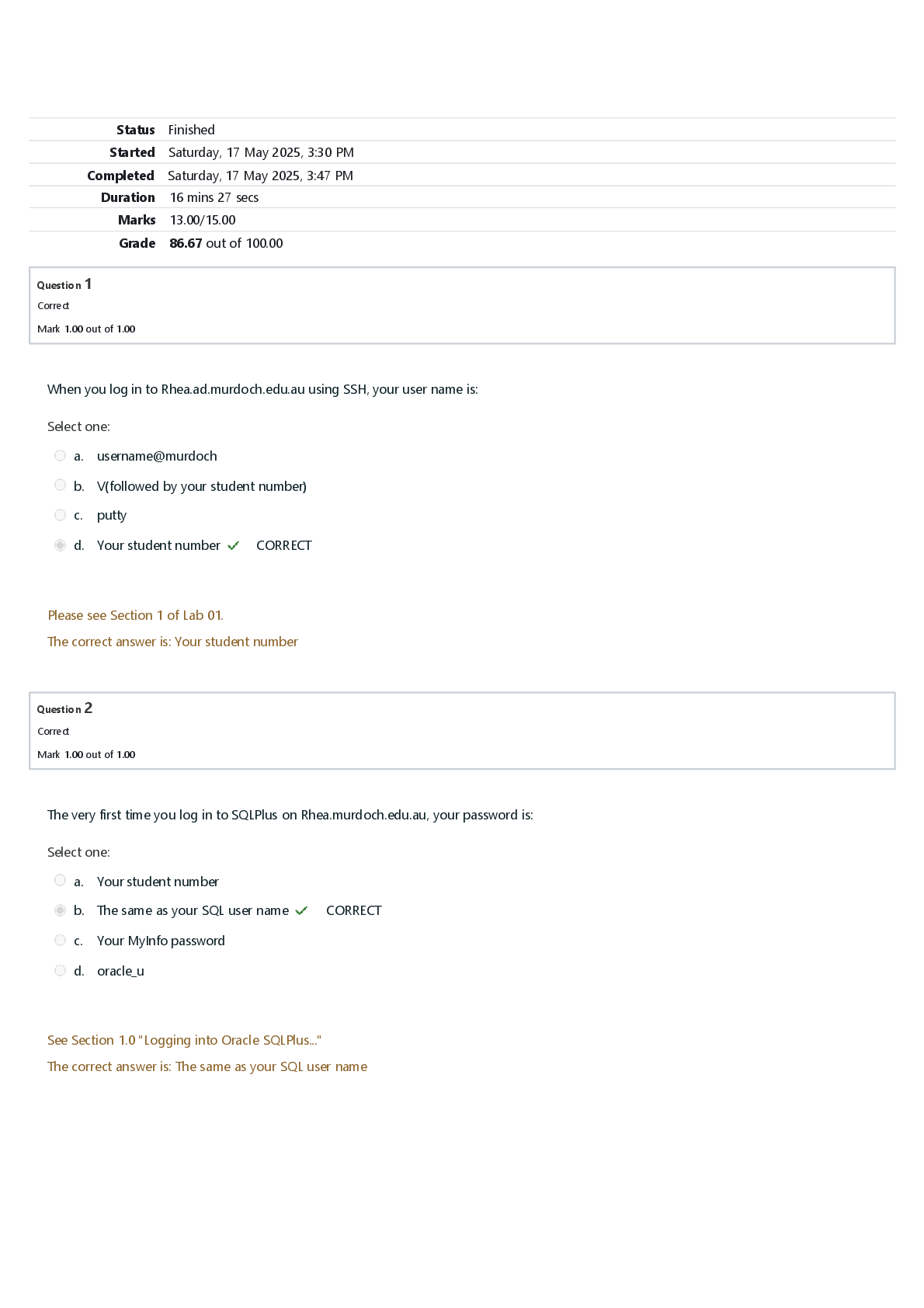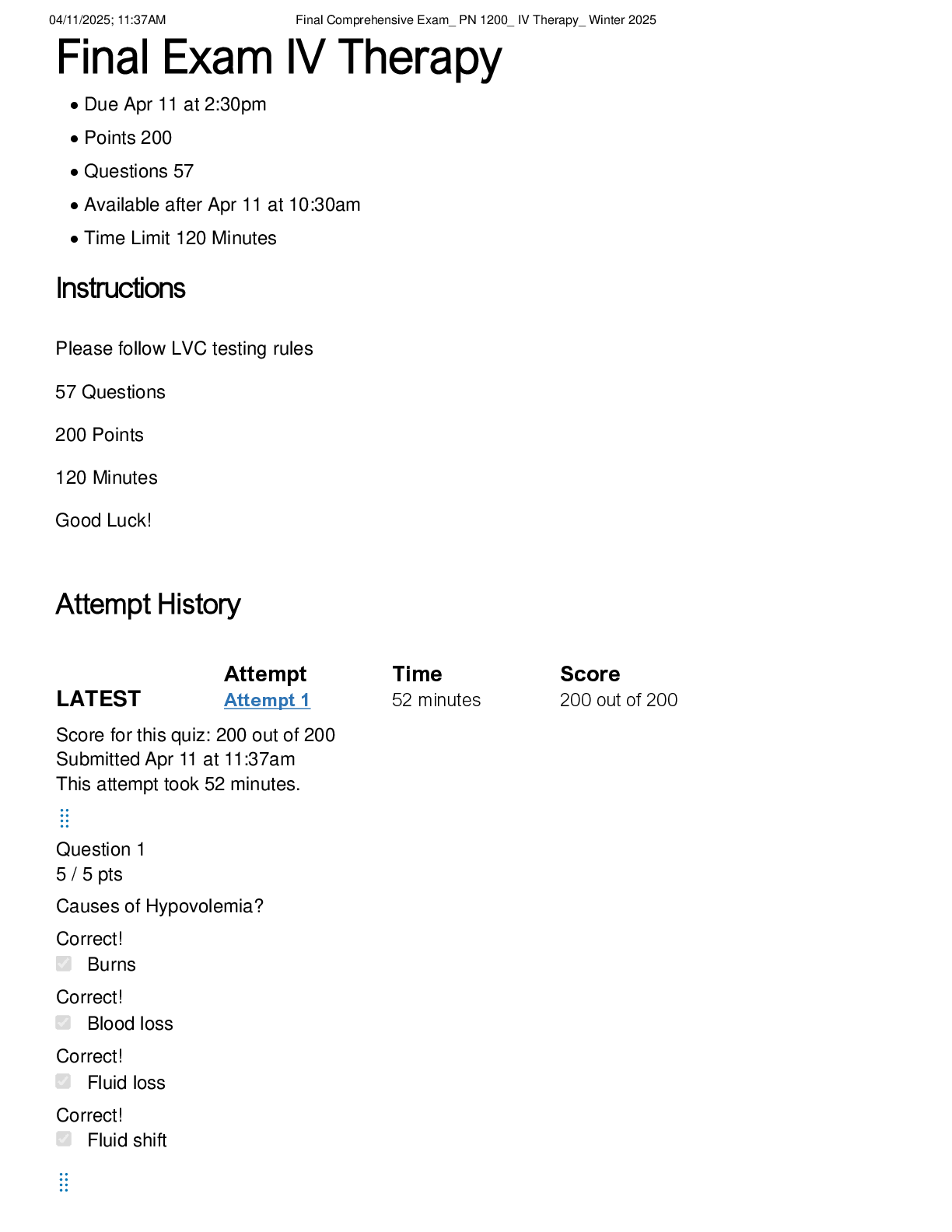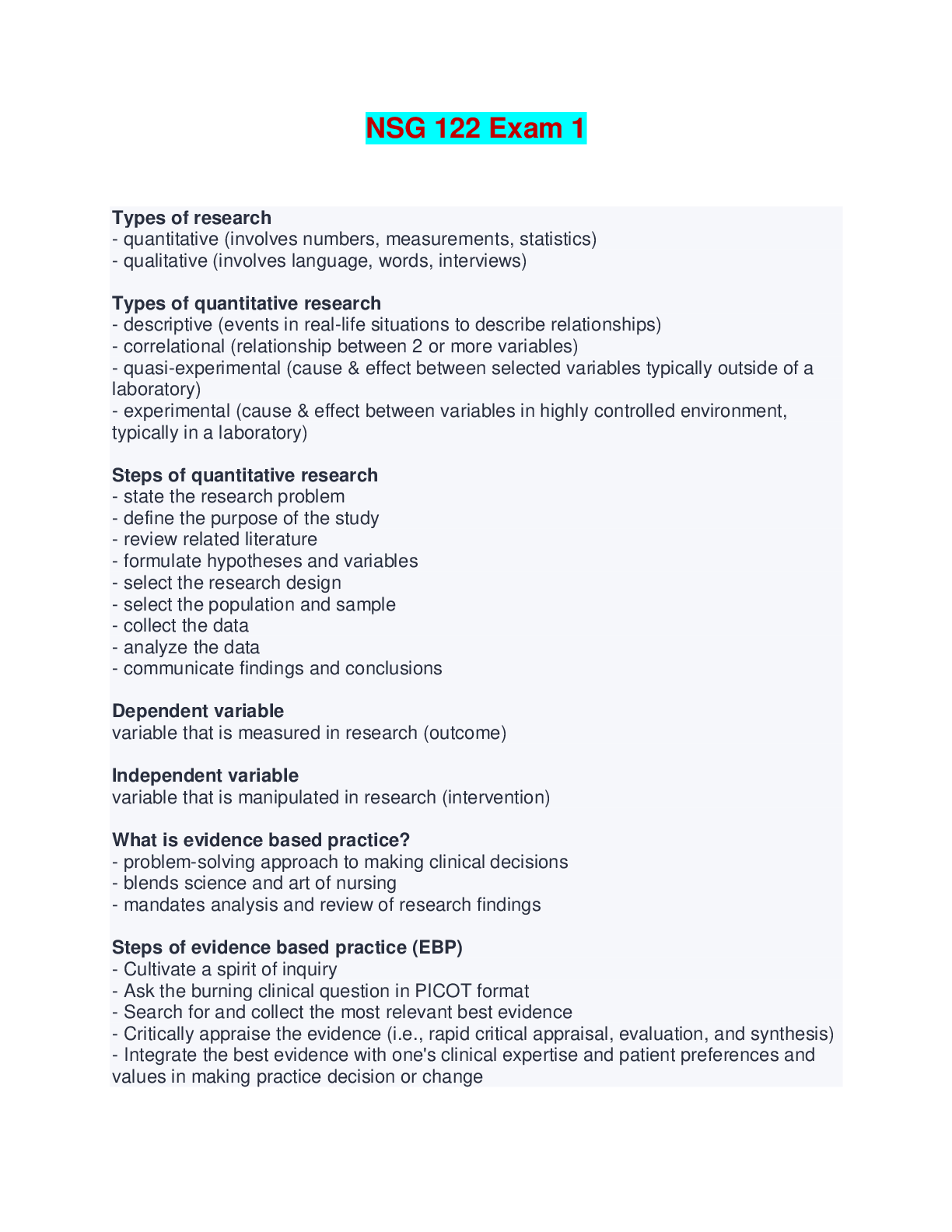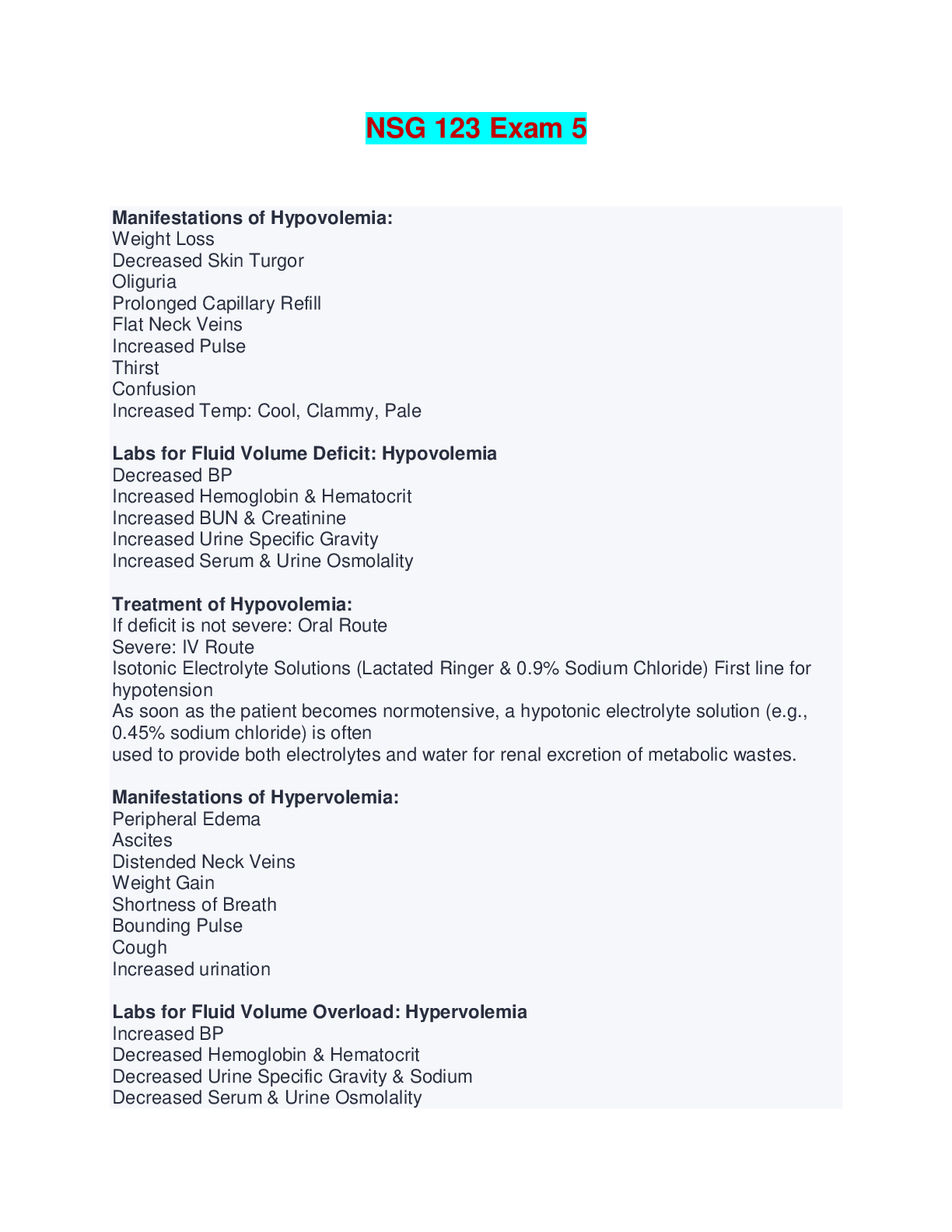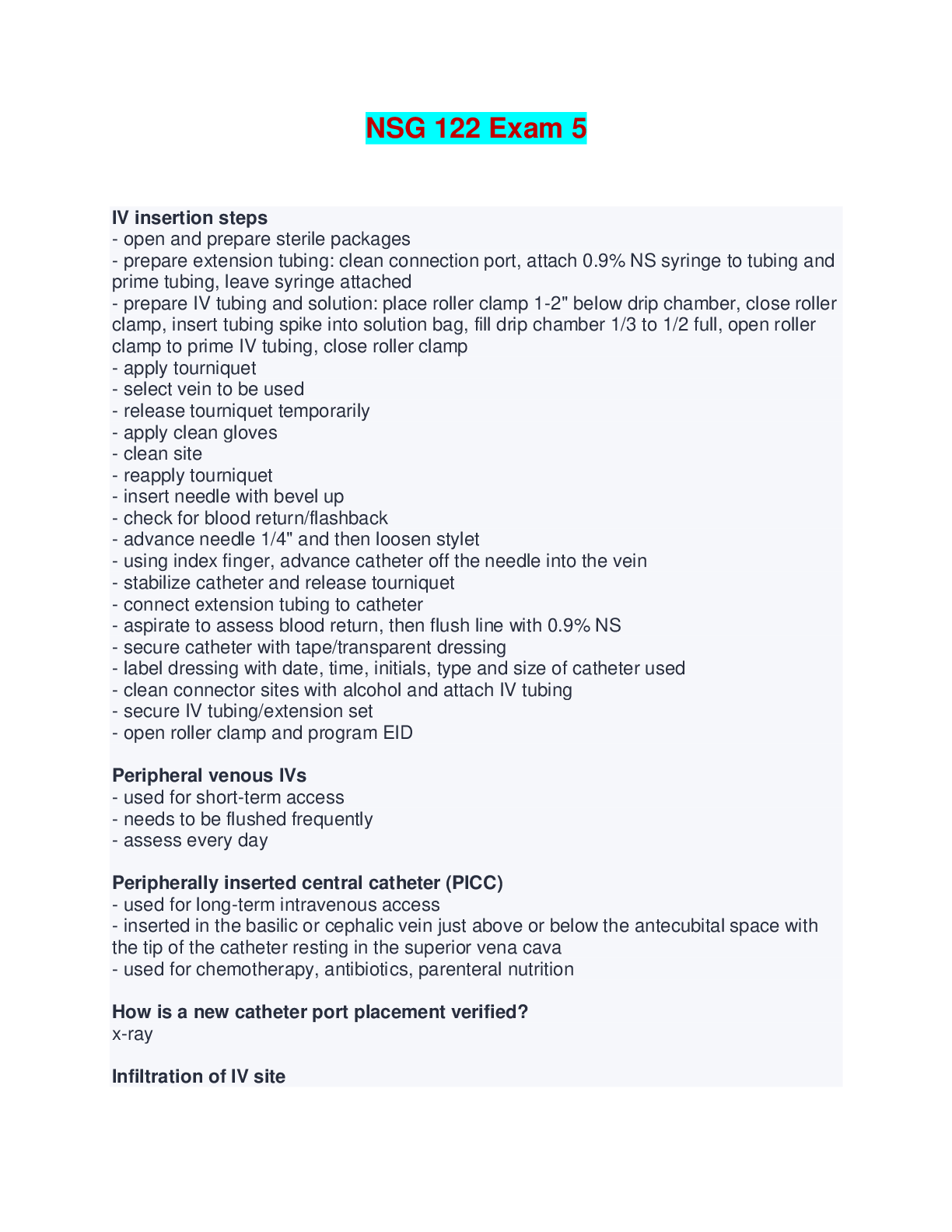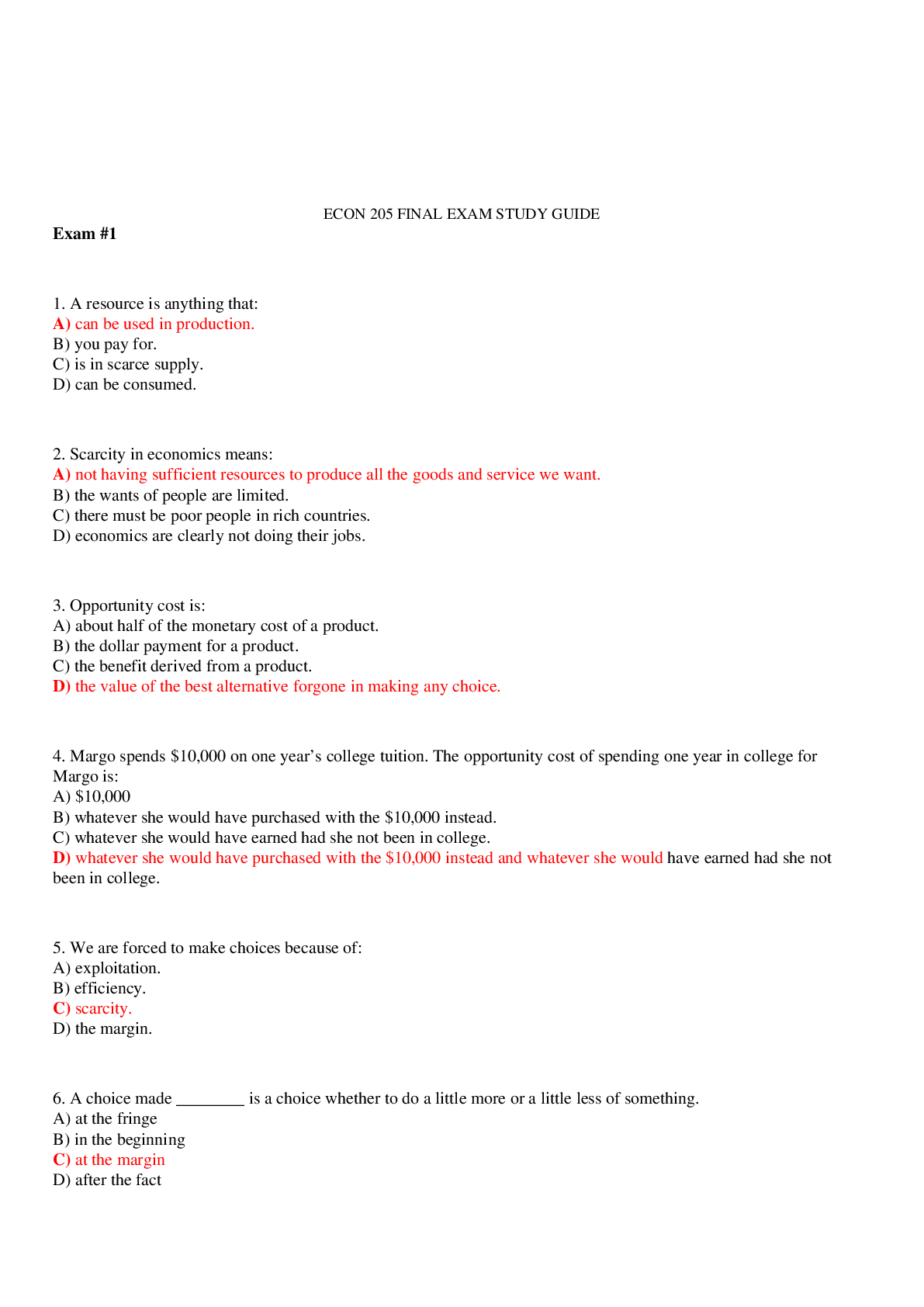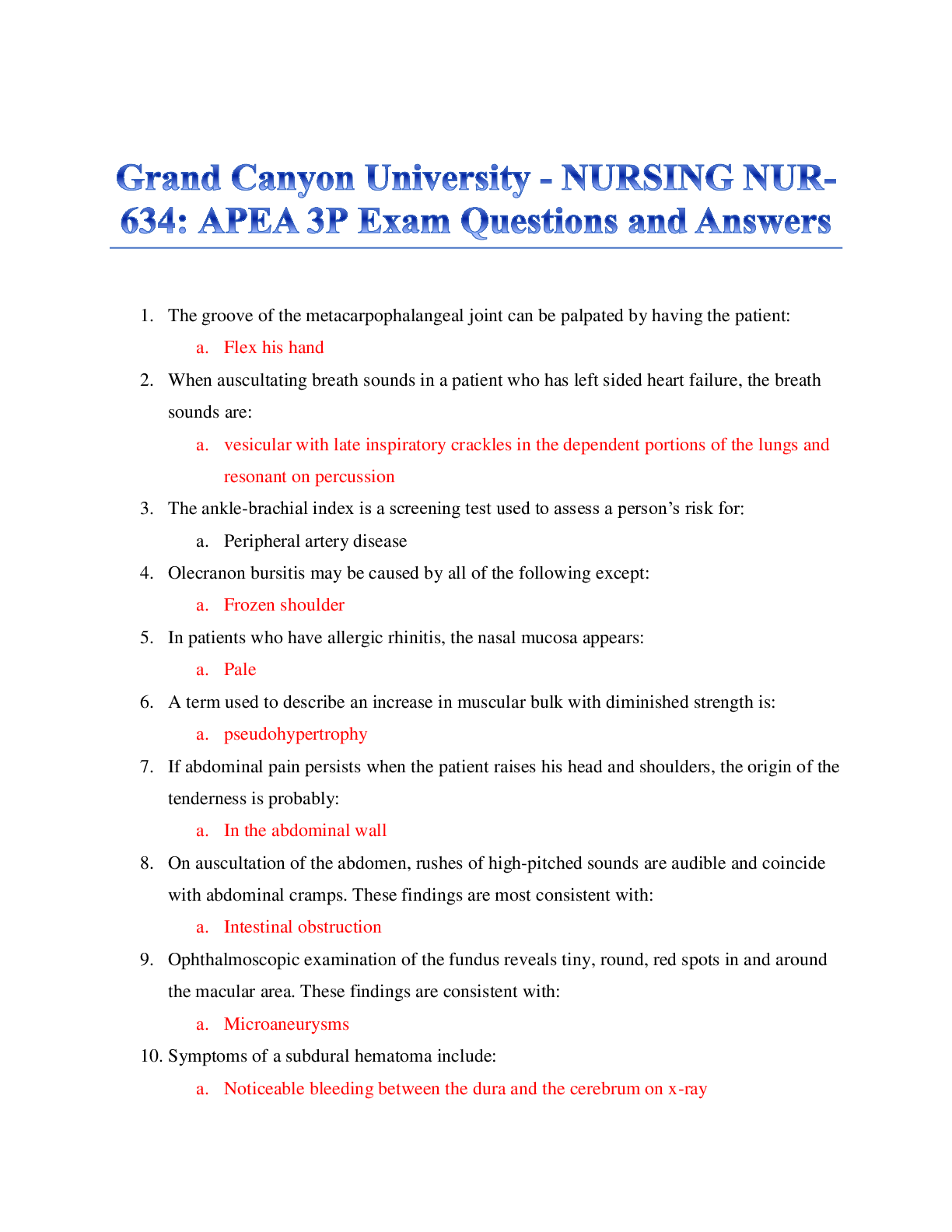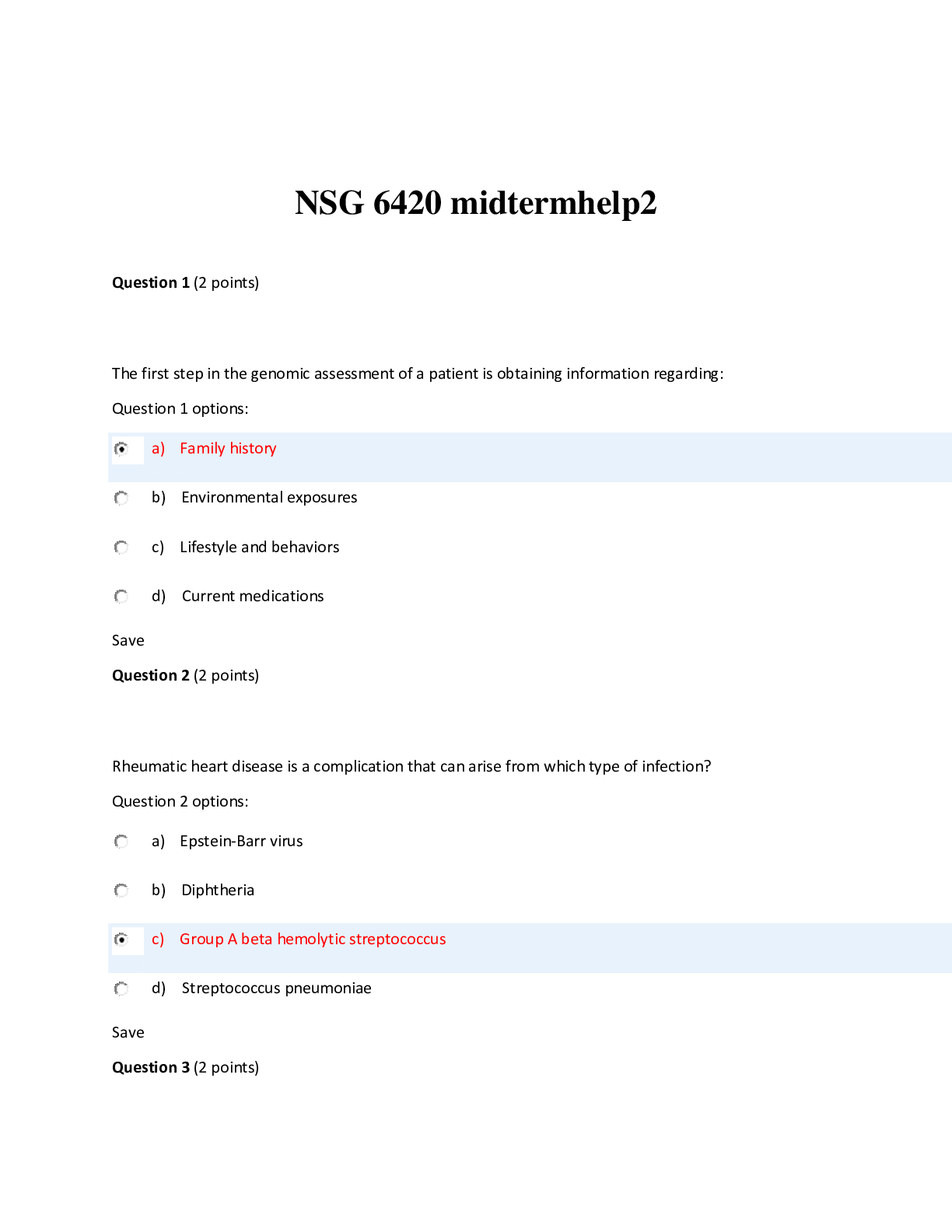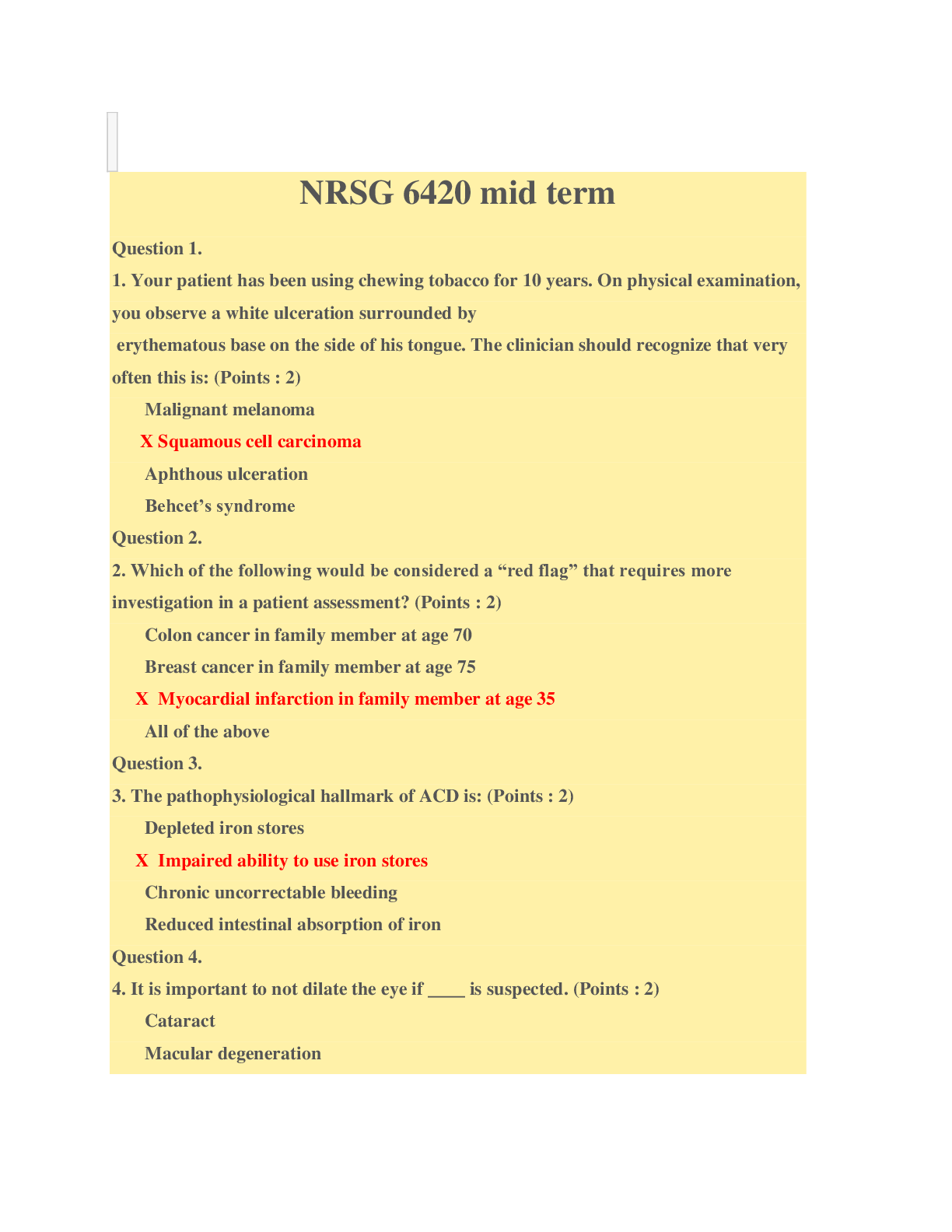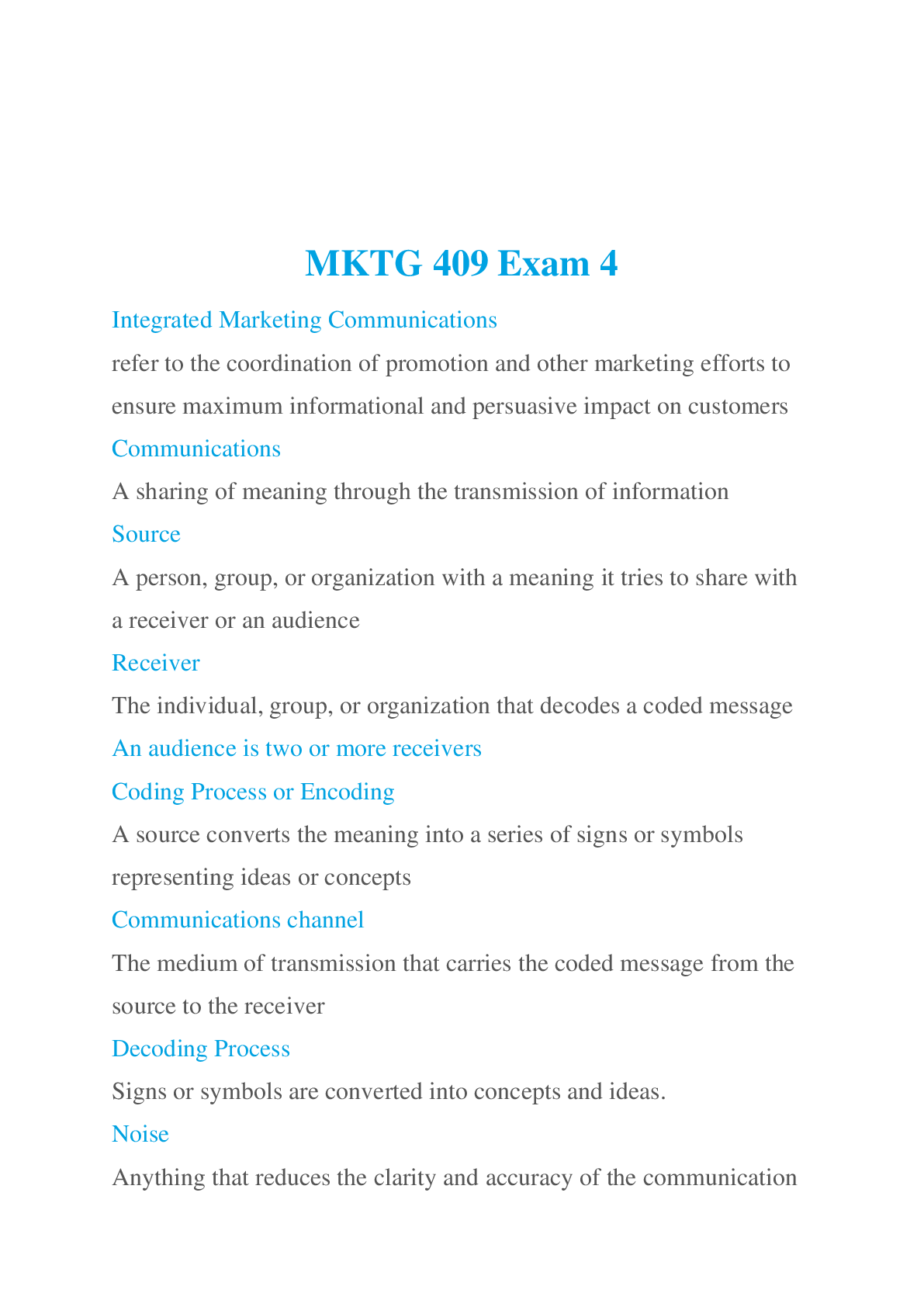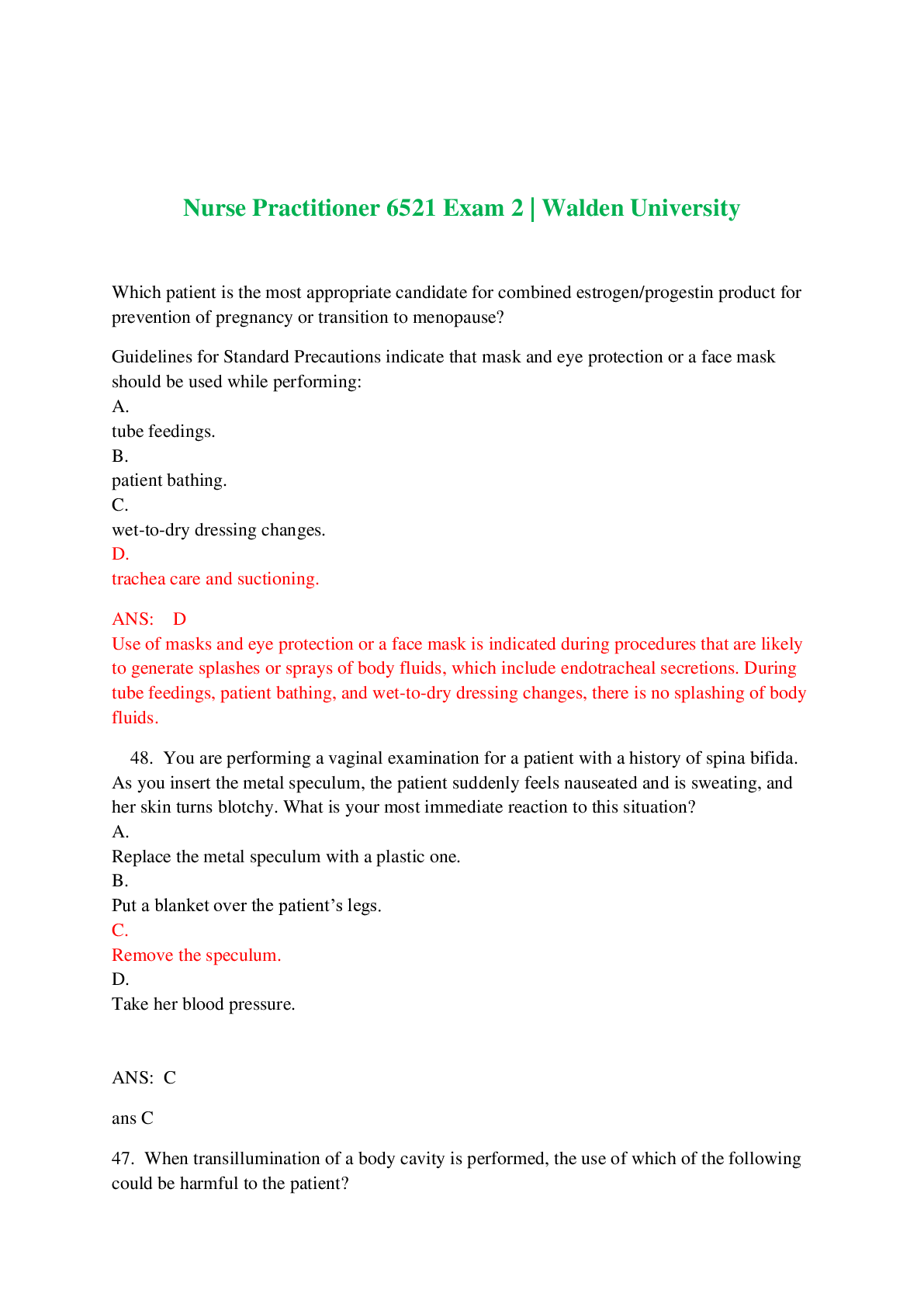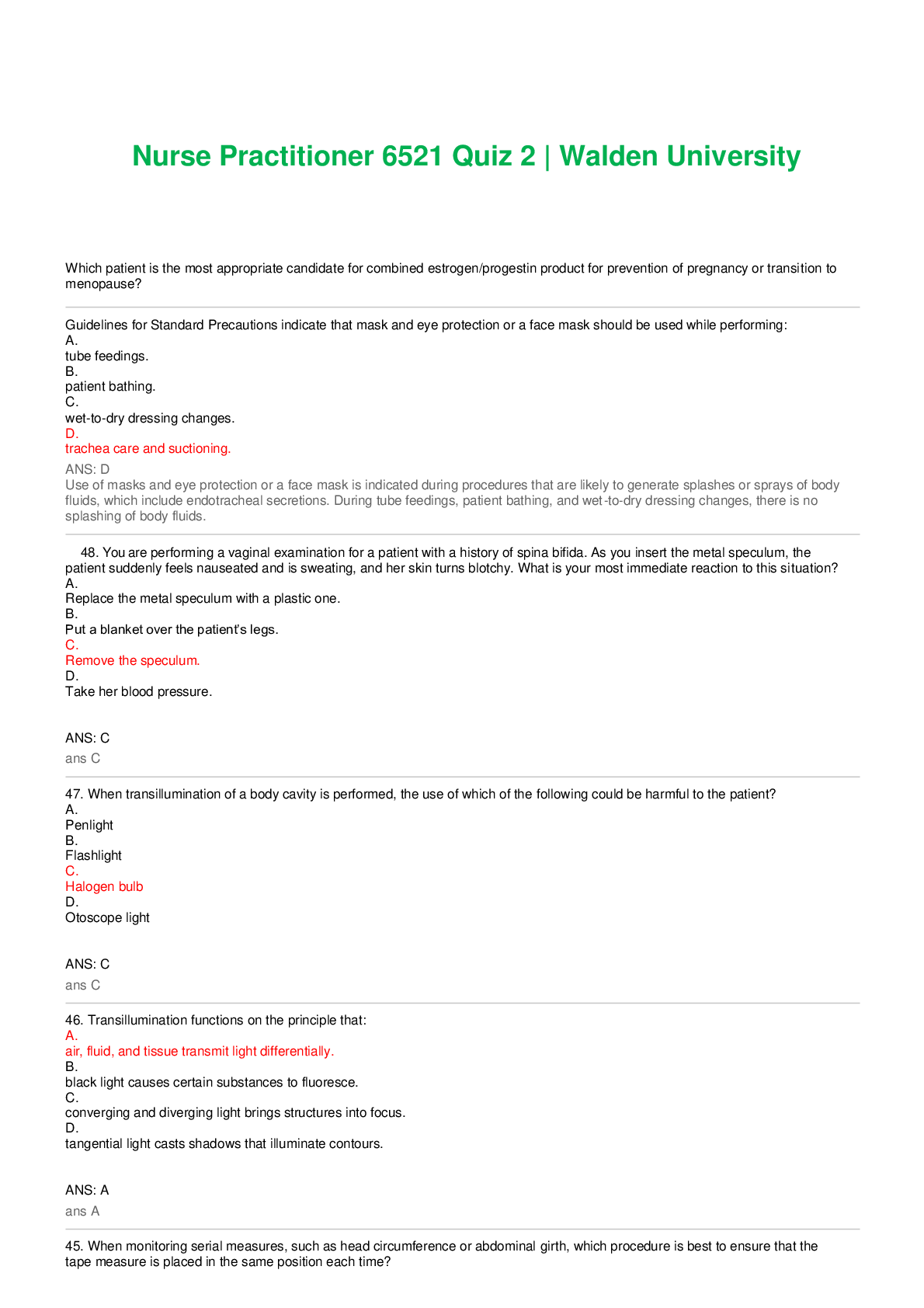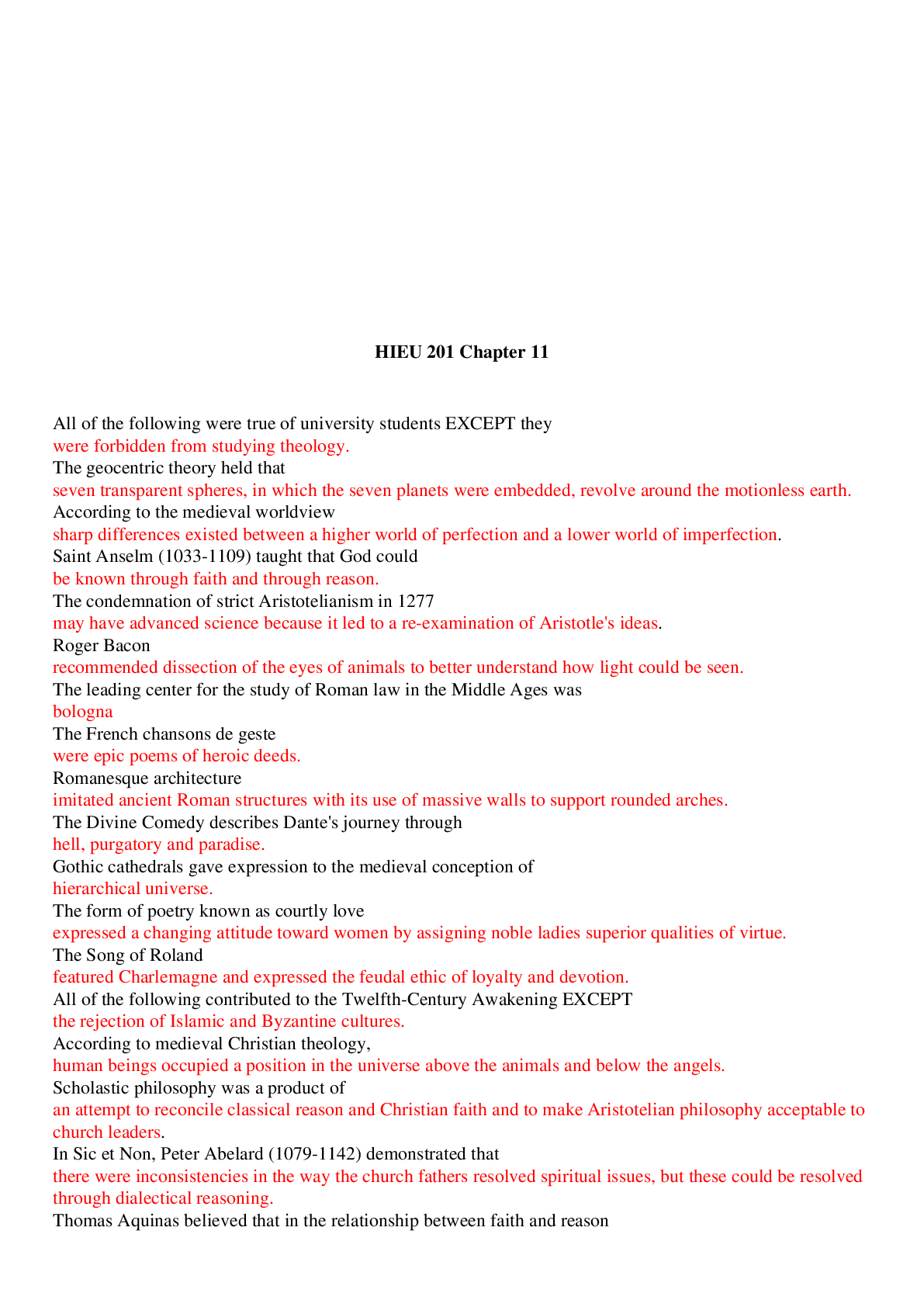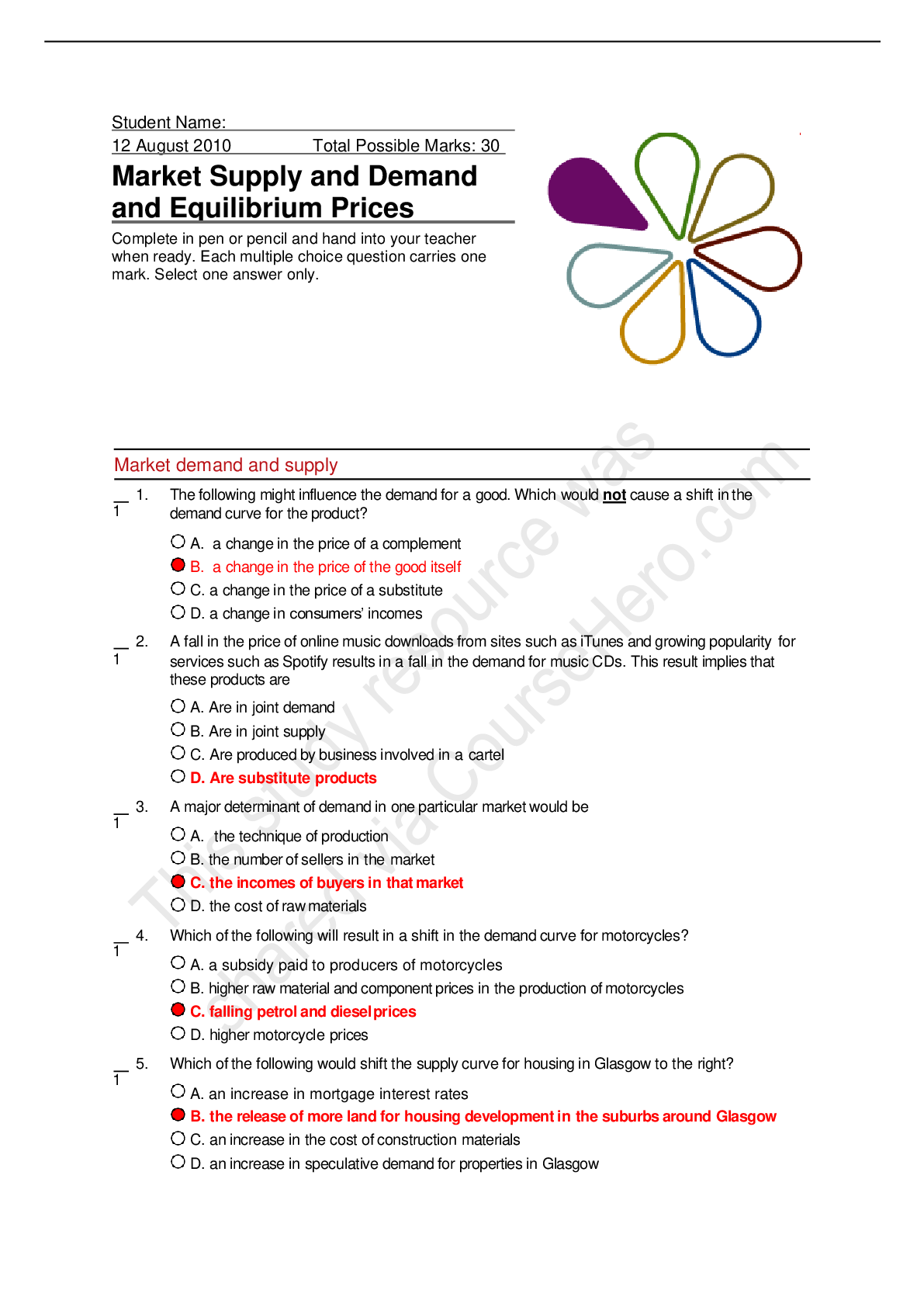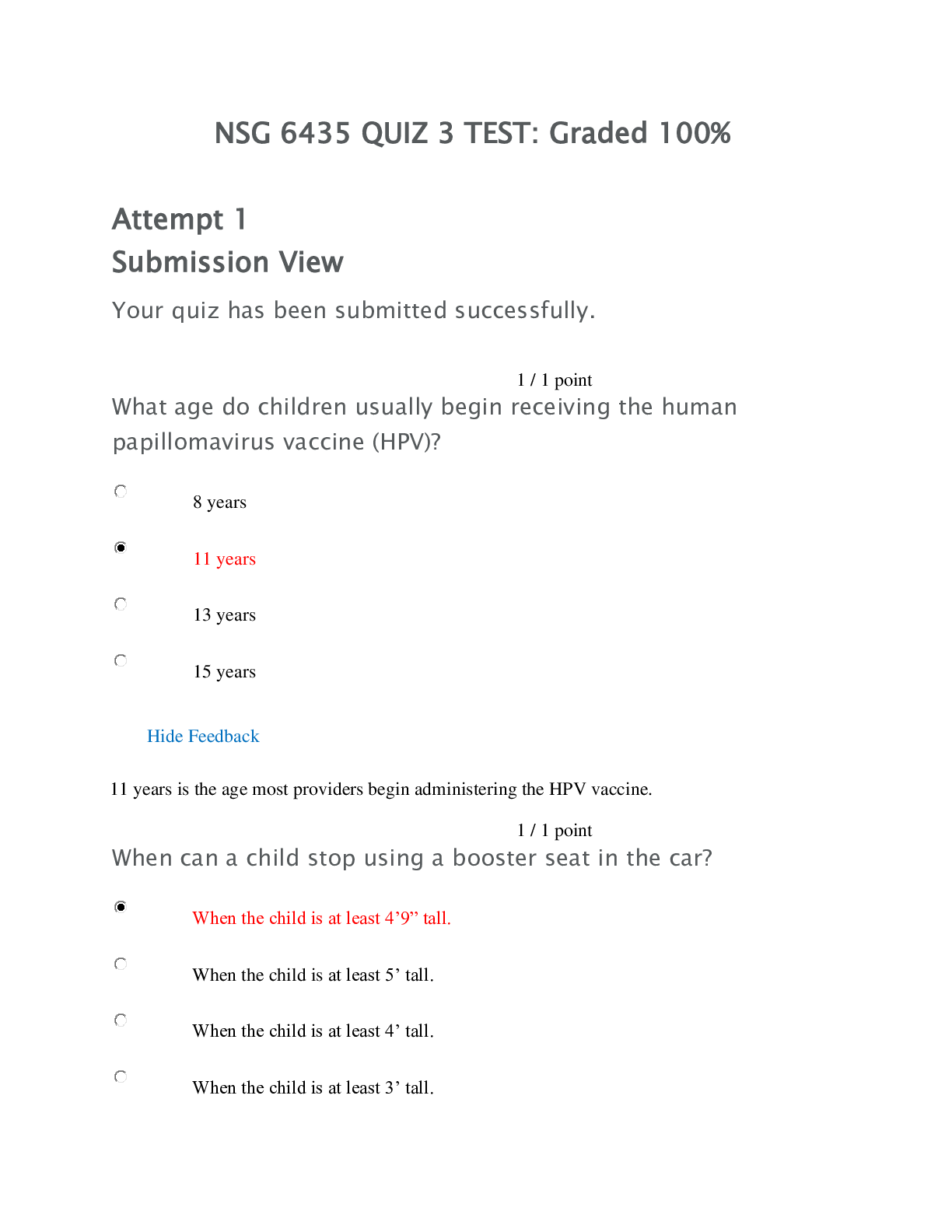Research Methods > EXAM > N262B Midterm Exam | Answered with Explanations (All)
N262B Midterm Exam | Answered with Explanations
Document Content and Description Below
N262B Midterm Exam | Answered with Explanations When implementing a new, evidence-based infection control regimen, which should constitute the final step in the nurses' EBP? a. calculating the cost ... savings that will be realized by using the new regimen b. sharing their experience with other healthcare professional c. implementing enforcement measures to ensure compliance with the new regimen d. conducting a meta-analysis of other infection control measures (Explanation: The final step in the EBP process is dissemination of the outcomes of the change. Financial considerations & enforcement measure are not components of the EBP process, and a meta-analysis would have been conducted much earlier in the process.) Which of the following is emphasized by the Institute of Medicine's Roundtable on Evidence-Based medicine? a. Ensuring that external evidence, rather than internal evidence, is integrated into care b. Fostering the level of learning that exists in the American healthcare system. c. Issuing clinical guidelines to ensure best nursing practices d. comparing the implementation of EBP in the US with that of other Western countries (Explanation: The Roundtable is charged w accelerating the progress toward a learning healthcare system, generating new evidence to support which healthcare strategies are most effective, and improving public health awareness and understanding about EBP. Comparison w other countries, issuing specific practice guidelines, and denigrating internal evidence are not components of its role) In the process of advocating for EBP in the unit guidelines, a nurse has met with skepticism from other members of the nursing staff, with several stating, "Evidence-based practice is good in theory, but it's almost impossible to actually search hundreds of journals & find the evidence." What could the nurse recommend? a. Self-reflection on the nurses' current practices b. Accessing the Cochrane Library c. contacting the clinical nurse educator on the unit d. beginning with lay publication before progressing to peer-reviewed journals. (Explanation: Databases such as the Cochrane Library and the National Guideline Clearinghouse can provide nurses with quick, easily retrievable, systematic reviews, and evidence-based guidelines to inform their practices. Self-reflection and contact with an educator may be useful measures but do not necessarily advance the cause of EBP. It would be inappropriate to recommend lay publications as a source of evidence. The primary care provider of a 49 yo male client has examined and briefly explained the evidence that supports beginning regular digital rectal exams. Which of the following factors would justify not performing digital rectal exams in this client's care? a. The client is vehemently opposed to undergoing digital rectal exams b. clinical practice guidelines for prostate care have not been published c. the clinician has been unable to find any large RCTs in a literature review d. the clinician has previously waited until clients are 55 to begin regular digital rectal exams. (Explanation: Pt preference, such as opposition to a particular assessment or intervention, should be implemented in clinical decision making. The lack of a large RCT or clinical practice guidelines does not independently justify rejecting the assessment. Likewise, the clinician's previous practice traditions do not provide sound justification. Which of the following clinical questions demonstrates understanding of and best exemplifies the PICOT format? a. what effect does parent's smoking have on the smoking habits of their children, aged 13-16? b. Among pts w cancer, what role does meditation, as compared with the use of benzodiazepines, have on anxiety levels during the 7 days following hospital admission? c. Among undergrad college students, what is the effectiveness of a sexual health campaign undertaken during the first 4 weeks of the fall semester as measured by incidence of new gonorrheal and clamydinl infections reported to the campus med. center? d. In clients aged 8-12, is the effectiveness of a pain scale using faces superior to a numeric rating scale in the ER context? (Explanation: Only the answer concerning pts w cancer contains the PICOT elements of Patient population, Intervention or Issue of interest, Comparison intervention or group, Outcome, and Time frame. The answer concerning smoking lacks and intervention, comparison, or time frame while the answer concerning undergraduate college students lacks a comparison. The answer concerning clients aged 8 - 12 lacks a specific outcome or time frame. A new administrator for a health clinic is concerned that some treatments are not as effective as they could be. After conducting a survey among the staff, it is discovered that the general consensus is the EBP process is not effective. Which of the following would be the best step for the administrator to do next? a. Leave the current treatments in place b. Present real-case scenarios in which EBP resulted in better care and long-term results. c. change one treatment at a time until EBPs are implemented d. assign small focus groups to research EBP to implement. (Explanation: Healthcare providers who do not believe EBP results in improved care and client outcomes need to be exposed to real-case scenarios in which evidence-based care resulted in better outcomes than care steeped in traditional practices. If the staff does not believe it will be a benefit, they will not be receptive to the changes or implement them. Leaving the current treatments in place does not benefit the clients in the long term. Which of the following factors provides the most important rationale for the consistent implementations of EBP? a. EBP provides for the most cost-effective client care b. EBP is accessible to all healthcare clinicians c. EBP provides consistency in care across healthcare settings d. EBP improves client outcomes (Explanations: The goal of health care is to improve the lives of the clients by either helping them maintain good health or helping them heal. While EBP does contribute to all choices, the most important is to improve client outcome.) A nursing supervisor is encouraging the increased use of EBP. Part of the plan is to encourage searching for appropriate reports to reference. This nurse is encouraging which of the following components of EBP? a. Patient preference b. internal evidence c. external evidence d External evidence (Explanation: External evidence refers to the most relevant & best research. Internal evidence comes from one's own clinical expertise & outcomes of projects that are conducted by the facility. Pt preference & value is the third component inherent to the definition of EBP. Which of the following should occur first in the steps of EBP? a. conducting an electronic search of the literature and ranking individual sources b. creating buy-in from the other clinicians who provide care at the facility c. Developing an inquisitive & curious mindset d. assessing whether the practices in question may, in fact, be evidence based (Explanation: Step 1 in the process when someone develops an inquisitive and curious mindset. At this point, the assessment of the practice and conducting the search can occur.) A meta-analysis will consist of the following? a. A statistical summary of the results from several different studies b. an examination of the theoretical and conceptual underpinnings of the issue c. an interdisciplinary analysis of the clinical question d. a qualitative study of different interventions related to the clinical question. Explanation: A meta-analysis consists generates an overall summary statistic that represents the effect of the intervention across multiple studies. It is not a type of qualitative study nor does it primarily address the theory behind the question. It is not necessarily interdisciplinary in nature. The certified nurse educator on a postsurgical unit has recently completed a client review after the implementation of a pilot program aimed at promoting early ambulation following surgery. Which of the following components of EBP is the nurse putting into practice? a. patient preferences b. research utilization c. experience d. Internal evidence (Explanation: Internal evidence is generated from outcomes management or quality improvement projects, such as a pilot program testing an intervention in a particular care setting. Pt preferences, research utilization, and experience are not paramount in the nurse's activities.) A nurse is conducting a literature review on the evidence regarding the use of vacuum dressings on pressure ulcers. After locating a recent study that appears to be relevant, which of the following questions would the nurse consider first when critically appraising the study? a. "are the findings of this study cost-effective in our clinical context?" b. "how would the implementation of this intervention affect our staffing needs?" c. "were the clients in the study similar to the clients on my unit?" d. "are the findings of the study significantly different from what we are currently doing on the unit?" (Explanation: Questions regarding the similarity between sample and the nurse's clients address the important issue of applicability. The question would need to be considered prior to assessing the impact on cost or staffing levels. The difference between the study and current practice on the unit are not directly related to critical appraisal.) The nurses on a postpartum unit want to create uniform guidelines for promoting breastfeeding on the unit. Which of the following sources is most likely to provide the best evidence? a. Evidence from a RCT that had more than 2,500 participants b. Evidence from a study that is widely regarded as a classic w/in the obstetrical nursing community c. Evidence from a systematic review of breastfeeding promotion studies that one of the nurses identified in an electronic database. d. the consensus opinion of the most senior nurses on the unit. (Explanation: The rating system for the hierarchy of evidence consists of seven levels with the top being l. Level l is evidence from a systematic review or meta-analysis of all relevant RCTs. Level ll consists of evidence obtained from well-designed RCTs. Level Vl consists of evidence from a single descriptive or qualitative studies, such as the classic study. Level Vll is evidence from the opinion of authorities and/or reports of expert committees, such as the opinion of most senior nurses on the unit.) A nurse is searching for recent information concerning the most effective follow-up method for clients following bariatric surgery to maintain weight loss. Which of the following questions is appropriate for the nurse to consider when appraising a study? a. were there control groups from my area? b. did the studies cover at least a year in follow-up c. Were the subjects randomly assigned to a group? d. will these methods be effective for everyone? (Explanation: Validity, reliability, and appraisal are the three key questions of the rapid critical appraisal process when evaluating a study. Validity includes determining whether the study of a subjects of a study were randomly assigned to a treatment or control group.) The family of an elderly client who is being treated for a DVT is concerned about the quality of care the client is receiving. The client has been improving, although more slowly than anticipated and now the family has overheard staff discussing asking the physician to discharge the client to a skilled-nursing facility because they need the bed. When confronted by the family, how should the staff respond? a. apologize and promise not to discuss with the physician. b. apologize and make sure future conversations among staff are done in private c. apologize for the inconvenience but explain the desperate need for the bed for a client who is sicker. d. apologize and recognize that the client comes first and should not be discharged until ready. (Explanation: Sometimes the discharge process is affected by the pressure for the use of the available beds. Client-centered means the client comes first. Making promises or explaining that other clients are more important would not be appropriate. All conversations should always be conducted in private to avoid confidentiality issues. A new nurse to the unit insists that the technique being used by several of the nurses when discontinuing IV lines is "outdated." The staff does not feel it is wrong for them to continue with what they are doing and see no need to change. The staff explains that they made changes a few years ago and see no reason to change now. Which of the following is MOST important to remember in this situation? a. the staff should be willing to update their skills and care to the most recent EBP b. the new nurse should respect the older staff and not push changes. c. the new nurse should be allowed to present the information and everyone then decide if they want to do it. d. There is no requirement that the staff should always be looking for the most current EBP without a reason. (Explanation: There are several central themes of evidentialism that support the use of evidence in clinical practices. One of them is that beliefs are based on current evidence, and there is no requirement that an individual must pursue more evidence without a reason. Everyone should show each other respect by not demanding that changes be made. The other choices are important but not the MOST important.) A new graduate nurse is excited to finally be working with clients now that he is finished with school. He has suggested an evidence-based practice (EBP) that he has learned in school but is having difficulties convincing the administration. Which of the following should the nurse emphasize in his discussions with the administration? a. It will decrease cost b. it will increase our competitiveness with the other providers in the community c. it will increase our client satisfaction d. it puts the emphasis on client values (Explanation: Client-centeredness is required for the integration of client preferences and values in EBP making. Client values should guide all clinical decisions to incorporate EBP. A nurse is caring for an elderly client whose family has been very involved in her care. The client is alert, oriented, and aware of what is happening. Her eldest son has been very insistent that everything is discussed with him first and he will then decide if the client should know. The nurse recognizes this is based on their cultural value; however, it is a conflict for providing the best care of this client. How should the nurse respond? a. Recognize the son's position, but explain that the decisions must come from the client. b. instruct the son to geta medical power of attorney to bypass the client c. withhold information from the client per the son's request d. compromise by agreeing to only discuss information with the son is present. (Explanation: "Nothing about me without me" is a slogan developed by Berwick. Clients must be allowed to make the decisions about their care as long as they are mentally competent. To acknowledge the son's request would be unethical. The client must also give the nurse permission to discuss her medical info w the son as per HIPAA. Nurse L provides care on a busy medical unit of an inner city hospital. Which of the nurse's actions best exemplifies clinical grasp? a. Nurse L is committed to reading and integrating the most recent, published evidence b. Nurse L is able to identify subtle changes in client condition that are often not obvious to other clinicians. c. nurse L has responded appropriately to clients in cardiac or respiratory arrest. d. nurse L makes a concerted effort to get to know clients' families. (Explanation: An aspect of clinical grasp is the ability to identify subtle transitions in client condition. Gathering evidence, providing good care during an emergency, and getting to know clients' families are all aspects of sound nursing care but do not directly exemplify the notion of clinical grasp. A student nurse is feeling a little overwhelmed on her clinicals. The unit is short-staffed d/t illness. All beds are filled w clients requiring moderate to extensive care, and one of the student supervisors is also ill. The student is trying hard to complete all the necessary tasks & provide proper care for her clients. In prioritizing her tasks, which of the following is the most important for her to remember? a. Document everything as it happens. b. always put the needs of the client first c. keep a list of what she doesn't get done and pass it on to the next shift. d. keep working until everything is completed, even if she needs to stay a little longer. (Explanation: The nurse should always put the needs of the client first. This can be demonstrated by one of the slogans developed by Berwick "the needs of the client come first." Documentation is important, but not as important as caring for the client. Passing her tasks off to someone else & staying late may not be an option as per the unit's policies. If she is not completing her tasks, then she should speak w the clinical supervisor & determine ways to help her complete her tasks. A clinic is considering incorporating EBP that they have discovered. They believe it will improve the care they are providing to the clients & improve the health of the community. Which of the following should the staff keep in mind as they evaluate this EBP? a. The risks vs benefits of not proceeding with the changes b. the effect on payment from the third-party payers c. The guidance & preference of the clientele d. the knowledge base of the staff (Explanation: Client-centeredness is an important aspect of EBP & even required. It is the integration of client preferences & values in evidence-based decision making. It should always guide all clinical decisions. The knowledge base of the staff will improve w cont education. Improving health care should improve the financial status of the clinic. A nursing supervisor has been trying to encourage the staff to improve client care with the use of EBP. The supervisor has hung a poster with a slogan suggested by Berwick (2009) in the nurses' station as a reminder. Which of the following is a slogan developed by Berwick? a. doing the least harm b. every client is the only client c. promote harmony, involve the client and family d. only the best for the client (Explanation: Three slogans were developed by Berwick in 2009: (1) the needs of the client come first; (2) nothing about me without me; and (3) every client is the only client. A nurse paged the attending physician because a postmastectomy client became somewhat agitated and tachypneic in recent hours. Despite the other nurses' assertion that the client was simply experiencing some anxiety, the nurse suspected a more serious etiology. The physician prescribed a single dose of a benzodiazepine, which was largely ineffective. Due to the nurse's persistence, diagnostics were performed, leading to a diagnosis of pulmonary embolism. Which of the following did the nurse exhibit? a. EBP b. Clinical expertise c. client-centered care d. best practice (Explanation: The nurse demonstrated aspects of clinical expertise, including engaging in detective work, recognizing qualitative distinctions, and recognizing changing clinical relevance. EBP may have formed the foundation of the nurse's actions, but they did not directly exemplify EBP. Client-centered care and best practice are not concepts that are specifically demonstrated by this scenario.) A nurse is having difficulties making a decision about a particular client care technique. The nurse believed that this technique was the best approach based on evidence, but another nurse is questioning this decision. How should the nurse proceed? a. find more evidence to back the decision b. find newer evidence describing a newer approach c. consult with the nursing supervisor before proceeding d. Continue using the technique until it proves ineffective. (Explanation: One of the themes of evidentialism is that beliefs are based on what we know at this moment, and there is no requirement to pursue more evidence at any particular time without a reason. Just because someone else is questioning the technique is not reason enough to discontinue unless the effectiveness, ethics or safety is being questioned.) A nurse has recently marked 10 years of practice on a medical unit. Which of the following aspects of "experience" is most likely to result in improved practice on the part of a nurse? a. increased years of practice in a consistent clinical environment b. exposure to more client interactions and conduction of more interventions c. Examination of interactions and events in the clinical context. d. engagement with a greater variety of clients and client populations (Explanation: Experience should be considered to be not merely the passage of time or the accumulation of interactions with a larger number and variety of clients. Rather, it is characterized by thoughtful reflection and examination that results in change.) A nurse remembered it had been a difficult day. They were short-staffed, and several elderly clients had been discharged to home. Two of those clients are now being readmitted d/t possible infections. The clients are telling the staff when they left they didn't know what they were to do. The hospital administration is upset because Medicare won't reimburse for their care. Which of the following would have best prevented this situation? Adequate personalized discharge planning. (Explanation: Clients must be prepared for discharge with adequate education provided so they will know what they need to do once they are home. This care should also be individualized to meet their individual needs. Extending everyone's admission unnecessarily, using home health care when not needed, and just assuming it was unpreventable are not considered one of the barriers of client-centered care.) Some of the staff in the ED are having difficulties w a new nurse. The new nurse has been using some techniques she learned while serving in a combat situation; however she cannot produce enough research to prove that her method is okay. Which of the following statements supports her use of these techniques? "I know this worked best in the field situation and resulted in better client outcome" (Explanation: One of the central themes of evidentialism that support the use of evidence in the clinical practice is that experiences that a person has had can be counted as evidence. Since this nurse has firsthand knowledge of the success of the technique, it can count as evidence. Doing something the same way, experimenting on clients and using techniques without proven results would not be appropriate, possibly unethical, and may actually hurt the client.) The local hospital has decided to send out questionnaires to clients after their discharge to inquire about their overall experience while a client. One theme appeared frequently, and it raised concern. Which of the following comments could be seen as a barrier to adequate care? "I wish I had a better idea of what to do once I got home" (Explanation: Researchers have identified four themes as barriers in the discharge process. One of them is that the clients did not feel prepared for discharge and post discharge care was not individualized. The client may not have had the choice in food, going home sooner, or a private room d/t their overall medical condition & treatment. ) How should a nurse best understand the concept of clinical expertise? Clinical expertise is enhanced by holistically knowing clients as individuals. (Explanation: Good judgement, and clinical expertise, depends on knowing the client; understanding his or her concerns, preferences, history, and understanding of the illness; and possessing the best relevant scientific knowledge. This scientific knowledge neither supersedes nor replaces clinical expertise, as both are necessary and each complements the other. Clinical expertise is not demonstrated simply by an increased level of formalized knowledge. ) A nurse has found his work at the hospice very rewarding and at times very difficult. The most frustrating part is when he sees a client "give up" and refuse treatment he feels will help them. How can this nurse best help his clients? Respect their wishes, allowing them to decide what they want. (Explanation: The nurse can best help these clients by respecting their wishes and decisions. He should continue to be available to answer questions but should not pressure the client or family to make the decision the nurse wants. Client-centered care is providing care that is respectful of and responsive to the individual preferences, needs and values. ) A nursing supervisor is evaluating different nurses to assist w implementing an EBP change on the unit. Which of the following individuals would be best to help teach the staff? Nurse K, who has great organizational skills (Explanation: There are three areas of knowledge and skill sets that are important and necessary for the nurse to possess to be successful and best assist the client. These are clinical, technical, adn organizational. The organizational set includes knowledge, skills and experience related to teamwork, organizational design and development, and leadership. ) [Show More]
Last updated: 1 year ago
Preview 5 out of 21 pages

Loading document previews ...
Buy this document to get the full access instantly
Instant Download Access after purchase
Buy NowInstant download
We Accept:

Reviews( 0 )
$16.00
Can't find what you want? Try our AI powered Search
Document information
Connected school, study & course
About the document
Uploaded On
Nov 17, 2024
Number of pages
21
Written in
All
Additional information
This document has been written for:
Uploaded
Nov 17, 2024
Downloads
0
Views
20


